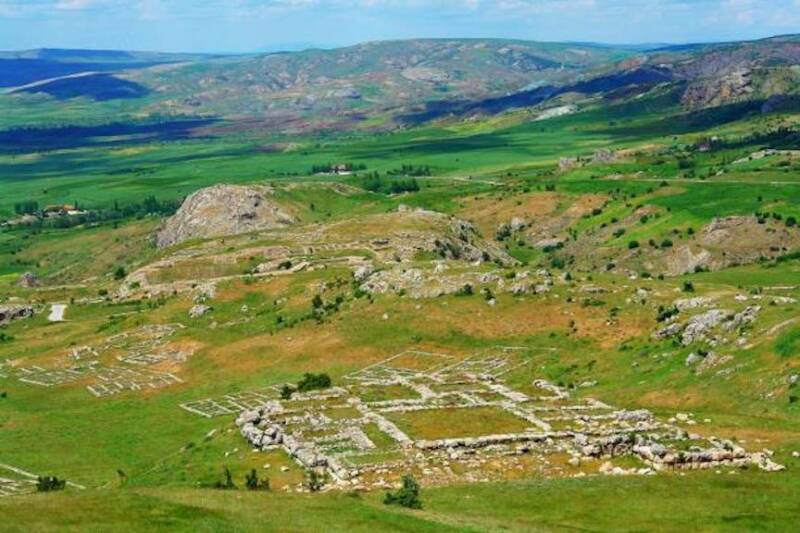The Hittites

The Hittites were an ancient people who spoke an Indo-European language, and established a kingdom centered at Hattusa in north-central Anatolia from the 18th century BC. In the 14th century BC, the Hittite Empire was at its height, encompassing central Anatolia, northwestern Syria as far as Ugarit, and upper Mesopotamia. After 1180 BC, the empire disintegrated into several independent "Neo-Hittite" city-states, some surviving until as late as the 8th century BCThe Hittites were also famous for their skill in building and using chariots, as the Battle of Kadesh demonstrated. The Hittites were pioneers of the Iron Age, manufacturing iron artifacts from as early as the 14th century BC, making them possibly even the first to do so. The Hittites passed much knowledge and lore from the Ancient Near East to the newly arrived Greeks in Europe.
Hittite prosperity was mostly dependent on control of the trade routes and metal sources. Because of the importance of northern Syria to the vital routes linking the Cilician Gates with Mesopotamia, defense of this area was crucial, and was soon put to the test by Egyptian expansion under Pharaoh Rameses II. The outcome of the Battle of Kadesh is uncertain, though it seems that the timely arrival of Egyptian reinforcements prevented total Hittite victory. The Egyptians forced the Hittites to take refuge in the fortress of Kadesh, but their own losses prevented them from sustaining a siege. This battle took place in the fifth year of Rameses II (c. 1274 BC by the most commonly used chronology).

Hattusa, also known as Hattusha, is an ancient city located near modern Boğazkale in the Çorum Province of Turkey’s Black Sea Region . This ancient city once served as the capital of the Hittite Empire, one of the superpowers of the ancient world.
In the Amarna Letters , which have been dated to the 14th century BC, the Hittites were referred to by the Egyptians as a major power, alongside Assyria, Mitanni, and Babylonia, and they were treated as equals.
Hattusa was established by the Hatti, the indigenous people who were living in that area prior to the coming of the Hittites. The origins of the Hittites are still a mystery, and they may have invaded / immigrated into Hatti territory, settled, and established their empire there.
Establishment of Hattusa
During the 3rd millennium BC, the Hatti had established a city state based on Hattusa. At this point of time, Hattusa was one of the many small city states in the region. Another possible city state of the Hatti is Kanesh, which is located close to Hattusa. A trading colony / colonies is / are said to have been established by the Assyrians around 2000 BC, and the name of Hattusa is first discovered from written documents dated to that period of time.
This period of Hattusa’s history came to an end around 1700 BC. During this time, the city was conquered and then razed to the ground by Anitta, a king of Kussara (a city state whose location has not yet been identified). The king is said to have left an inscription to proclaim his victory over Hattusa and lay a curse on the ground the city stood on and on anyone who might rebuild the city and rule there. Anitta was either a Hittite king or as a forerunner of the later Hittites.

The Hittites were an ancient people who spoke an Indo-European language, and established a kingdom centered at Hattusa in north-central Anatolia from the 18th century BC. In the 14th century BC, the Hittite Empire was at its height, encompassing central Anatolia, northwestern Syria as far as Ugarit, and upper Mesopotamia. After 1180 BC, the empire disintegrated into several independent "Neo-Hittite" city-states, some surviving until as late as the 8th century BCThe Hittites were also famous for their skill in building and using chariots, as the Battle of Kadesh demonstrated. The Hittites were pioneers of the Iron Age, manufacturing iron artifacts from as early as the 14th century BC, making them possibly even the first to do so. The Hittites passed much knowledge and lore from the Ancient Near East to the newly arrived Greeks in Europe.
Hittite prosperity was mostly dependent on control of the trade routes and metal sources. Because of the importance of northern Syria to the vital routes linking the Cilician Gates with Mesopotamia, defense of this area was crucial, and was soon put to the test by Egyptian expansion under Pharaoh Rameses II. The outcome of the Battle of Kadesh is uncertain, though it seems that the timely arrival of Egyptian reinforcements prevented total Hittite victory. The Egyptians forced the Hittites to take refuge in the fortress of Kadesh, but their own losses prevented them from sustaining a siege. This battle took place in the fifth year of Rameses II (c. 1274 BC by the most commonly used chronology).
Create Your Own Website With Webador